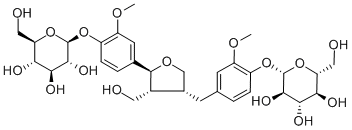(1) 鍾南山院士2009年開始做板藍根的研究,有2篇新聞報道:
鍾南山院士領銜板藍根抗病毒研究有望獲美國專利_新聞_騰訊網
鍾南山:板藍根抗病毒原因初步探明_新聞中心_新浪網
(2)鍾南山院士2013年在一個期刊發了一篇文章(2012年還有一篇粗提取混合物的文章,效果更差一些)。摘錄如下:
Antiviral activity of Isatis indigotica root-derived clemastanin B against human and avian influenza A and B viruses in vitro.
Abstract
Clemastanin B, 7S,8R,8'R-(-)-lariciresinol-4,4'-bis-O-β-D-glucopyranoside, is one of the major lignans extracted from Isatis indigotica root (IIR). In this study, the anti-influenza activities of clemastanin B were evaluated in vitro. Clemastanin B was found to inhibit different subtypes of human (H1N1, including swine-origin H1N1; H3N2 and influenza B) and avian influenza viruses (H6N2, H7N3, H9N2) at different magnitudes of activity (IC50 0.087-0.72 mg/ml) while this compound was inactive against respiratory syncytial virus (RSV), adenovirus 3 (ADV3), parainfluenza virus 3 (PIV3), enterovirus 71 (EV71) and human rhinovirus (HRV). An apparent virus titer reduction was detected when MDCK cells were treated with clemastanin B after viral infection, particularly at the early stage, and the ribonucleoprotein (RNP) of the influenza virus was retained in the nucleus after treatment with clemastanin B. These results demonstrated that clemastanin B targets viral endocytosis, uncoating or RNP export from the nucleus. Furthermore, treatment with clemastanin B did not easily result in the emergence of viral drug resistance. The effects of clemastanin B demonstrated in this study may promote the antiviral study of IIR, but additional studies are required to define the anti-influenza mechanism(s).
- PMID:
- 23403777
- [PubMed - indexed for MEDLINE]
(3)板藍根的純提取物藥效如何?從體外實驗 (in vitro)結果可見:IC50 = 0.087-0.72 mg/mL.以下為板藍根有效成分提純物Clemastanin B的分子式:

經換算,Clemastanin B 的IC50 約為 毫摩爾/升數量級。 一般來說,有效地抗菌抗病毒的藥物IC50 在微摩爾到納摩爾/升數量級(越小越好)。
以下為一個抗HIV 實驗藥的優化(IC50 從 1.6 µM 優化到 7.2 nM)

換算:
1 M = 1 mol/L
1 摩爾 = 1,000 毫摩爾 = 1,000,000 微摩爾 = 1,000,000,000 納摩爾。
1 克 = 1,000 毫克 = 1,000,000 微克 = 1,000,000,000 納克。
(4) 板藍根的有效成分純淨提純物對流感病毒有很弱的抑製作用。與抗病毒的西藥相比,抑製能力還差百萬倍(毫摩爾數量級與納摩爾數量級)。
Sensitivity of influenza viruses to zanamivir and oseltamivir: a study performed on viruses circulating in France prior to the introduction of neuraminidase inhibitors in clinical practice.
Abstract
Influenza virus neuraminidase inhibitors (NAIs) were introduced in clinical practice in various parts of the world since 1999 but were only scarcely distributed in France. Prior to the generalization of zanamivir and oseltamivir utilization in our country, we decided to test a large panel of influenza strains to establish the baseline sensitivity of these viruses to anti-neuraminidase drugs, based upon a fluorometric neuraminidase enzymatic test. Our study was performed on clinical samples collected by practitioners of the GROG network (Groupe Régional d'Observation de la Grippe) in the south of France during the 2002-2003 influenza season. Out of 355 isolates tested in the fluorometric neuraminidase activity assay, 267 isolates could be included in inhibition assay against anti-neuraminidase drugs. Differences in IC50 range were found according to the subtype and the anti-neuraminidase drug. Influenza B and A/H1N1 viruses appeared to be more sensitive to zanamivir than to oseltamivir (mean B IC50 values: 4.19 nM versus 13 nM; mean H1N1 IC50 values: 0.92 nM versus 1.34 nM), while A/H1N2 and A/H3N2 viruses were more sensitive to oseltamivir than to zanamivir (mean H3N2 IC50 values: 0.67 nM versus 2.28 nM; mean H1N2 IC50 values: 0.9 nM versus 3.09 nM). Out of 128 N2 carrying isolates, 10 isolates had zanamivir or oseltamivir IC50 values in upper limits compared to their respective data range. Sequencing of the neuraminidase of these outliers N2 highlighted several mutations, but none of them were associated with resistance to neuraminidase inhibitors.
==============
板藍根粗提取混合物IC50:0.39-4.3 mg/ml
In vitro inhibition of influenza virus infection by a crude extract from Isatis indigotica root resulting in the prevention of viral attachment.
Abstract
Isatis indigotica root (IIR) has been widely used as a Chinese medicinal herb to treat regular seasonal influenza over the long history of traditional Chinese medicinal practice. However, its inhibitory activities against influenza virus infections along with the associated mechanisms have not been investigated comprehensively. In this study, the chemical nature, mode of action and in vitro anti-influenza activities of a crude extract (G2) of IIR were characterized. The extract was found to inhibit different subtypes of human or avian influenza viruses at various magnitudes of activity (IC50 0.39-4.3 mg/ml) in vitro, including A/PR/8/34 (H1N1), A/FM/1/47 (H1N1), A/Aichi/2/68 (H3N2), seasonal influenza (A/Guangzhou/GIRD/02/09 H1N1, B/Guangzhou/GIRD/08/09), novel swine-originating influenza (A/Guangzhou/GIRD/07/09, H1N1), A/Duck/Guangdong/09 (H6N2), A/Duck/Guangdong/94 (H7N3) and A/Chicken/Guangdong/96 (H9N2), while G2 was inactive against respiratory syncytial virus (RSV), adenovirus 3 (ADV3), parainfluenza virus 3 (PIV3) and enterovirus 71 (EV71). An apparent virus titer reduction was detected when the influenza viruses were pretreated with G2, and it was also shown that G2 exhibited inhibitory effects on influenza virus hemagglutination. In addition, G2 played a role in the early stages of infection, which did not easily result in the emergence of virus drug resistance. Thus, G2 may affect the attachment of influenza virus by interfering with the viral particles, thereby preventing the binding of influenza virus to the host cell surface.




